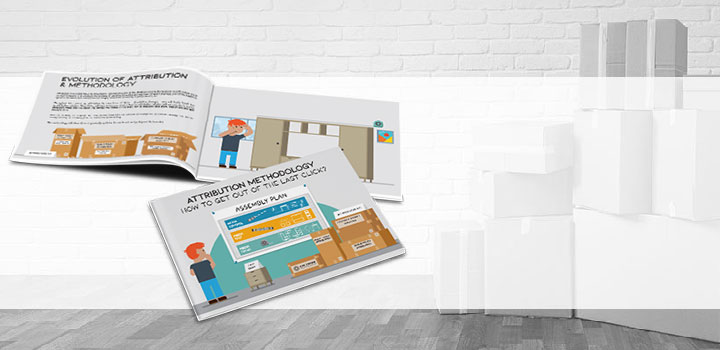Home > Blog > Trucchi > Un kit di attribuzione per ottimizzare il proprio media mix
When you receive a piece of furniture to assemble, the package consists of a kit on one hand and assembly instructions on the other. In your attribution solution, it’s the same. You will find an attribution kit that includes three elements:
- Single-Touch Attribution: customizable models that assign one-touch to a conversion.
- Customer Journey Analytics: set of reports to better understand the role of each channel in the Customer Journey.
- Multi-Touch Attribution: models that assign multiple touches to the conversion.
This kit contains all the tools to optimize your Mix Media and will be the basis of your marketing attribution method.
Attribution white paper, understand the challenges. Download it now!
THE SINGLE TOUCH ATTRIBUTION (STA)
As mentioned in one of our previous article “Attribution models … We explain!”, Single Touch Attribution Marketing (STA) attribution models are one way to move towards a righter attribution by removing bias and revaluing certain channels. Here is a non-exhaustive list of the different models from the STA:
- Last Click: Last click valuated at 100%
- Last Click off session: the last click, by deprioritizing (i.e. not taking into account) the interaction that occurs during the session generating the sale, is valued at 100%
- Last Click off branding: he last click, by deprioritizing the Adwords branding campaigns (in order to value the previous channel that generated Awareness), is valued at 100%
- Last Touchpoint: the last interaction (impression or click) is valued at 100 %
- Last paid channel: as its name indicates, the last paid channel is valued at 100% (with the deprioritization of the free channels)
- First Click: the first click is valued at 100 %
- First Impression: the first impression is valued at 100%
- First Touchpoint: the first interaction (click or impression) is valued at 100%
STA models are the most used models to control daily performance. They are also used in “comparison” to better understand valuation bias. Several models can be used in control or analysis logics.
THE CUSTOMER JOURNEY ANALYTICS
Customer Journey Analytics (CJA) is a set of reporting that helps you better understand the role of your channels in engagement creation. It should allow you to identify trends in under & over-valuation of your channels in order to fuel your future decisions to reallocate budgets or to highlight tests to conduct in your media mix:
- Attendance report: identifies the presence of a channel, corresponding to the number of times the channel is present regardless of its position in the Customer Journey.
- Delay report: highlighting the delay between a first marketing touch and the conversion.
- Frequency report: identifying the number of marketing interactions needed to convert.
- Path Report: Highlighting the most powerful combinations of marketing channels to generate conversions.
- Autonomy / complementarity: identification of the solist character of the channel or the performing combinations.
All of these reports can be combined during the analysis to better understand what really generates engagement to the user.
THE MULTI TOUCH ATTRIBUTION
The Multi Touch Attribution (MTA) is a model that allows to spread the credit of a conversion on several channels. There are standard models:
- Linear – Linear models give to all interactions the same credit for a conversion. Each point of contact gets an equal credit (rather than assigning weights).
- Time Decay – Temporal decomposition models are more accurate than linear models because they give more credit to interactions that occur closer to the conversion. As a result, the previous contact points receive less weight.
- U-Shaped – A U-shaped pattern gives more weight to the first and last touch, typically 40% each, and then divides the remaining value of the conversion among the remaining points of contact.
- W-shape – A W-shaped model is similar to a U-shaped model, but it assigns 90% of the weight to the first, converting and last contact points, and distributes the remaining 10% to all other points of contact.
- Full Path – A full path model takes into account the three contact points highlighted by the w-shaped model and adds the final touch that result in the conversion.
But you can also build your own custom data-driven model. Custom analysis models let you define your own weights. By their very nature, they allow you to grant varying degrees of credit to the points of contact that enabled the conversion.
The MTA is the model towards which any advertiser dreams to go to value the channels on the Customer Journey. But the path is still long. It is currently mainly used in an analytics logic, the understanding of the customer journey.
With this kit, you will be able to identify the contribution of each channel and optimize your media mix. But as for any piece of furniture to assemble, it will have to be coupled with an assembly plan: an attribution methodology. This will allow you to reconsider the attribution in analysis logics both short term & longer term, which will allow you to find insights helping you to optimize your media mix.



